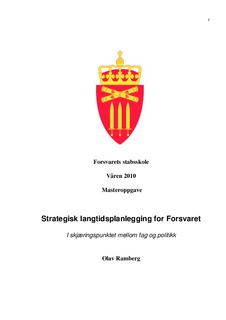| dc.description.abstract | This master thesis seeks to explore how the long term defence planning (LTDP) of the Norwegian defence forces has been developed in the intersection between political- and professional military considerations in the period from 1945 to the present. Furthermore, I have tried to identify similarities and differences between the Norwegian defence and the central administration. I have chosen a theoretical-historical framework for studying the relationship between the political leadership and the central administration.
Formative postures of the LTDP have been studied through analysing how key actors have contributed in the process. The key actors are the Parliament (the Storting), the Defence Commissions, the government and the MoD, the Chief of Defence (CHOD), and the Norwegian Defence Research Establishment (NDRE). Among these key actors the Parliament, the government and the MoD may be seen as representing the political influence on the process, while the CHOD represent the professional influence and the NDRE the civil-analytical influence. The Defence Commissions purpose is to build consensus and commitment to the LTDP, both in the political and military environment, as in the Norwegian society as whole.
This thesis suggests that there were some similarities in the development of the shifting influence of political and professional considerations between the defence organisation and the central administration in general. However, the findings indicate that the political ambition to govern and control the defence sector has been much stronger than for the rest of the central administration. The defence was regarded as a “special case”. This strong political will has over the years influenced the LTDP in different ways, from close political control to more freedom for the professionals, but always with the same overall political intention: to have a strong influence on the process. The findings also indicate that this will be the case when it comes to the new LTDP model which the MoD is about to implement. | en_US |
